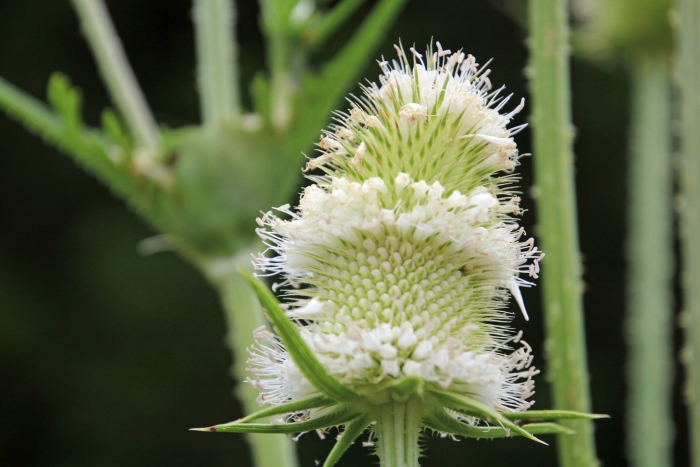Cutleaf Teasel
(Dipsacus laciniatus)
Cutleaf Teasel (Dipsacus laciniatus)
/
/

James Todd McCann
CC BY 4.0
Image By:
James Todd McCann
Recorded By:
Copyright:
CC BY 4.0
Copyright Notice:
Photo by: James Todd McCann | License Type: CC BY 4.0 | License URL: http://creativecommons.org/licenses/by/4.0/ | Rights Holder: James Todd McCann | Publisher: iNaturalist | Date Created: 2022-08-04T14:29:23-07:00 |












Estimated Native Range
Summary
Dipsacus laciniatus, commonly known as cutleaf teasel, is a robust perennial herb native to Europe and Asia, specifically found in riparian zones, along stream banks, and in moist grasslands. It can grow to an imposing height of 7-10 feet with prickly, hollow stems that bear lanceolate leaves with deeply cut lobes. From July to September, it produces white to pale lavender flowers in dense, egg-shaped heads that are highly attractive to pollinators but can be quite prickly to the touch. The flowers are subtended by spiny bracts, adding to the plant’s distinctive appearance.
Cutleaf teasel is valued for its unique architectural form and is sometimes used in dried flower arrangements. In its native habitat, it is often found in moist, fertile soils, but it can adapt to a range of soil conditions. It prefers full sun to partial shade and requires moderate water. While it can be a striking addition to naturalistic plantings, it is important to be aware of its invasive potential outside its native range. It can spread aggressively by seed, and its deep taproot makes it difficult to eradicate once established. In some regions, it is considered a noxious weed and is subject to control measures.CC BY-SA 4.0
Cutleaf teasel is valued for its unique architectural form and is sometimes used in dried flower arrangements. In its native habitat, it is often found in moist, fertile soils, but it can adapt to a range of soil conditions. It prefers full sun to partial shade and requires moderate water. While it can be a striking addition to naturalistic plantings, it is important to be aware of its invasive potential outside its native range. It can spread aggressively by seed, and its deep taproot makes it difficult to eradicate once established. In some regions, it is considered a noxious weed and is subject to control measures.CC BY-SA 4.0
Plant Description
- Plant Type: Herb
- Height: 6-10 feet
- Width: 1.5-2.5 feet
- Growth Rate: Rapid
- Flower Color: Purple, White
- Flowering Season: Summer, Fall
- Leaf Retention: Deciduous
Growth Requirements
- Sun: Full Sun
- Water: Medium
- Drainage: Medium, Fast
Common Uses
Bird Garden
Natural Habitat
Native to riparian zones and moist grasslands in Europe and Asia
Other Names
Common Names: Common Teasel, Cut-Leaved Teasel, Venus’s-Bath
Scientific Names: , Dipsacus laciniatus, Dipsacus fullonum, Dipsacus fullonum subsp. laciniatus, Dipsacus fullonum var. laciniatus, Dipsacus laciniatus var. comosus, Dipsacus microcephalus, Dipsacus sylvestris subsp. laciniatus,
GBIF Accepted Name: